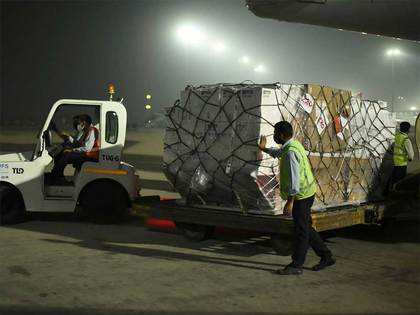 AFP
AFPTrue, it is a task as complex as massive. But urgency must overrule ‘teething troubles’. Hopefully, the systems were put in place as soon as — or even before — the government officially acknowledged the limitations of aatmanirbhar, and reversed the policy of spurning foreign aid that the previous government had brought in. Yet, the obsession with managing perceptions rather than the surge seems to have affected the aid issue, too.
This is not about ‘ambulance-chasers’ or ‘foreign media conspiracy’ any more. The images of a gasping populace and the forest-fire of pyres are not selective images. They provide a tragic, real picture that has, rightly, stirred many governments and private individuals to provide medical supplies and money required to fight this scourge.
Unfortunately, this government continues to fob off media with a maun vrat and bureaucratese. Amitabh Kant stated that ‘the government has a streamlined and systematic mechanism working 24x7 to fast-track and clear the goods’. The Niti Aayog CEO assured the stakeholders that ‘all items received up to May 5 have been allocated and dispatched to states and institutions following the health ministry’s standard operating procedures’. Which makes one wonder how the governments of Uttar Pradesh, Gujarat and Madhya Pradesh had earlier said that they had got ‘all they had asked for’ — growing clamour for liquid medical oxygen across the country, including in these states, notwithstanding.
Oxfam’s India director for programmes and advocacy Pankaj Anand told BBC last week, ‘I don’t think anyone has any clarity on where the aid is going.’ Anand’s despair over ‘no tracker on any website giving you an answer’ may have provided a response from Niti Aayog later supplying the link covidaid.niti.gov.in. But websites are like digestive systems — what you get out of them depends on what you put into them.
Action is happening on this front. But there are two worries. One, will this site work better than the unstable CoWIN app? And that all monetary aid is ‘encouraged to be made to’ the opaque PM-CARES fund adds to the nervousness.
It is important that donor governments constantly check what is being fed into the official aid platform. Aid with the ‘strings’ of transparency and accountability attached is not only permitted, but also imperative. In this case, there is none of the old ‘donor-driven agendas’ to worry about. The intent is simply to supplement India’s flailing healthcare system. And flags must be raised if aid is found to reinforce state patronage instead.
At the time of the roll-out of the Covid vaccine(s) this January, it was believed that centralisation was the only way to keep track of everything — procurement, stockpiling, allotment, cold-chain, shelf life and human data base. Dr VK Paul, member (health) of Niti Aayog, along with health secretary Rajesh Bhushan, led the Covid vaccination drive. Over-centralisation became the roadblock. Those heading the respective state task forces complained of ‘too much Delhi control’ stymieing quick response. The alleged problem was that the Centre was holding the power-reins while the states were saddled with the responsibility of making the mare run.
Politics played puppeteer to vaccine distribution. This was exacerbated most recently when stocks ran critically low. The centralised control room had mismanaged supply and miscalculated demand. The Shiv Sena-NCP-Congress government in Maharashtra, then the worst-hit state in the country, was reportedly given too little in terms of vaccine stocks by the Centre. Expect a repeat run of this kind of altercation in the allocation of humanitarian aid in non-BJP states like Maharashtra and West Bengal.
The second wave of the Covid pandemic is upon us because political chest-thumping scoffed at science. The same mistake is repeated by placing the distribution of relief in the hands of an ‘empowered group of ministers’, ministries of external affairs, health and home. Mercifully, the Indian Red Cross has also been roped in. What is needed is a non-partisan rapid action force, drawing on India’s formidable managerial and logistics talent pool.
The truth is, the situation is too dire to leave it in the hands of a political nanny state, answerable only to her employers.










 Get Unlimited Access to The Economic Times
Get Unlimited Access to The Economic Times
